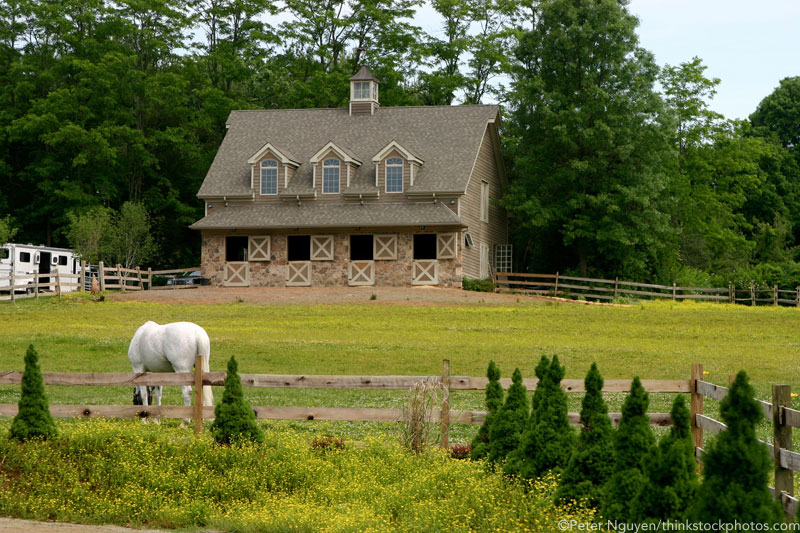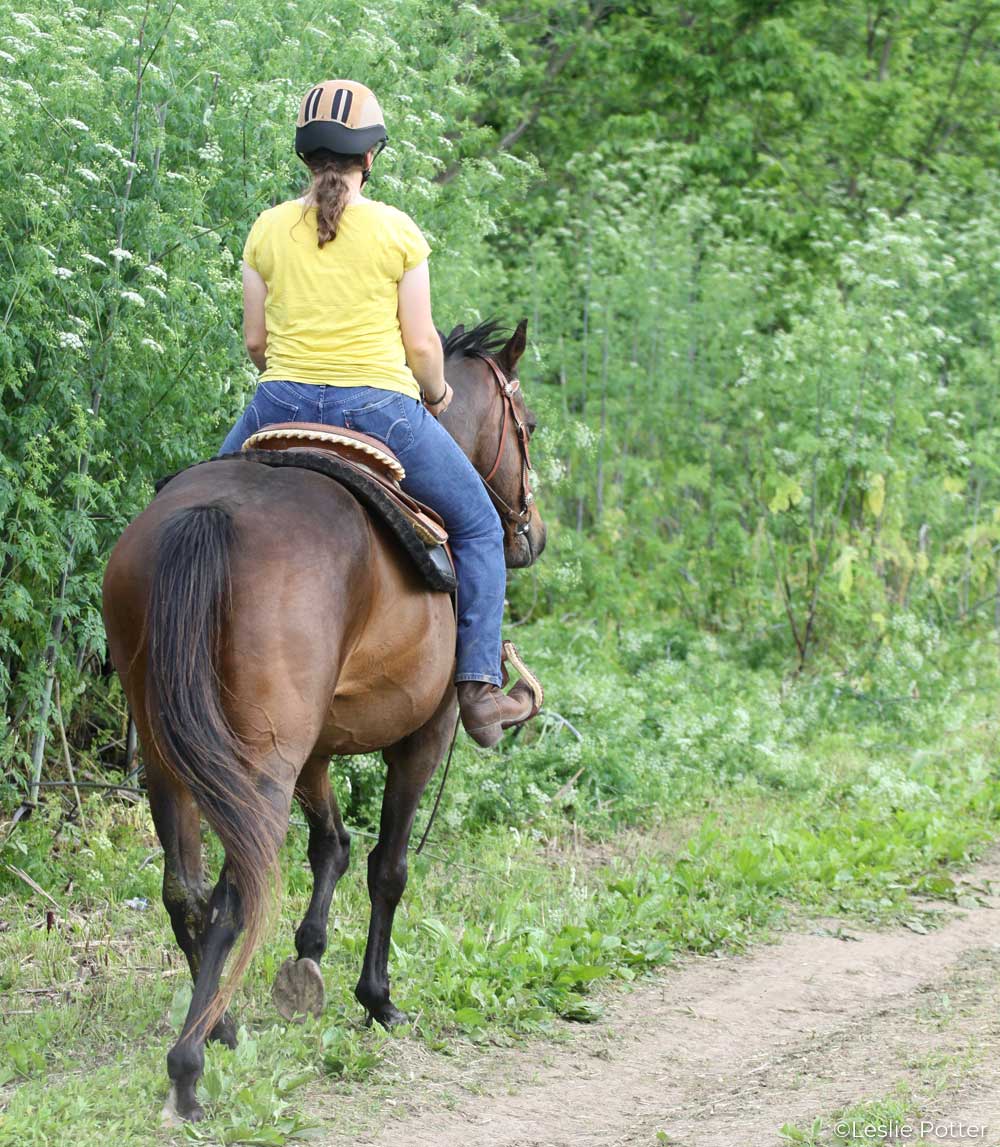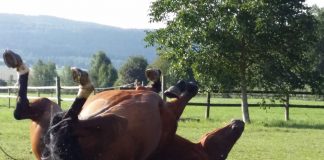As the warm days of summer begin to really heat up, so does the temperament of the season’s stingers and biters. These testy creatures slither, fly, crawl or buzz around us for most of the summer, and we invariably give them little if any thought, unless we’ve been stung, bitten or had some other unpleasant surprise encounter.

While most cause little harm to the general population of humans and horses, others are capable of producing serious lesions or may even trigger severe allergic reactions. Let’s take a look at our most common stingers and biters—bees, wasps, hornets, fire ants, spiders and venomous snakes.
Social Stingers
Bees, wasps, hornets and fire ants will vigorously attack in defense of their nests. The instant burning sensation from a sting is the insects’ foremost weapon in driving foreseen enemies away.
In most sting scenarios, pain and inflammation are primarily limited to a small area around the sting site, although dramatic swelling might occur if your horse receives a sting around the muzzle or eyes. Depending on the horse and how many stings he received, an allergic reaction could be slight to very serious.
How to Identify a Sting
In general, horses rarely exhibit serious reactions to a single insect sting. In fact, very often you will only learn that your horse has been stung when you stumble upon the small, soft swelling during a grooming session.
“Should your horse exhibit excessive swelling, irritability, pain or hives, he is potentially having a bad reaction to the insect venom,” explains Dr. Nancy S. Loving, DVM, of Boulder, Colo. “Hives indicate that the horse has developed an allergic response. Usually this condition is transient, but the presence of hives often precedes a more generalized allergic response that could include swelling and occlusion of the airways.”
Treating Stings
Of all the summer stingers, bees are the only ones with barbs on their stingers. If you find a bee’s stinger left protruding from your horse’s hide, gently remove the stinger, making an effort not to squeeze the venom sac, which inadvertently injects more venom into your horse. “If removal of the stinger can not be easily or safely done, it’s best to have your veterinarian attend to the problem,” says Dr. Loving.
For any sting, whether it results from a fire ant, bee, wasp or hornet, applying an ice pack to the sting site for 10 to 15 minutes will cool down the painful burning sensation, plus impede further swelling. “A dab of Icthammol or a baking soda poultice might also be soothing and will act as a drawing agent to pull out the inflammation,” advises Dr. Loving.
Stings accompanied with hives or that involve the head will require extra attention. Monitor your horse closely. Any time there is swelling in the head area, stay alert for signs of discomfort or trouble breathing. “Usually it’s best to arrange veterinary evaluation and treatment rather than wait until a more serious issue develops,” says Dr. Loving.
Along Came a Spider
A bite from a black widow or brown recluse spider, although not usually a life threatening problem for your horse, can create a difficult lesion to heal. “A typical reaction to a spider bite creates local inflammation and sloughing of affected skin and soft tissue,” says Dr. Loving. “Horses occasionally develop mild to moderate systemic symptoms, such as fever and depression.
“The bite should be treated as any wound, with careful attention dedicated to avoid infection. Your veterinarian will remove any necrotic (dead) tissue, then will minimize further inflammation with anti-inflammatory medications, plus administer a tetanus toxoid booster. Depending on the extent or seriousness of the bite wound, your vet may also put your horse on systemic antibiotics,” explains Dr. Loving.
Slithering Snakes
Venomous snakes are divided into two categories—the elapids, such as the coral snake, and the pit vipers, which include the copperhead and cottonmouth (water moccasin), along with 13 species of rattlesnake.
Snakebites in horses may be a more common occurrence in some parts of the country than others. “However, snakebites in veterinary practice seem fewer in number than one might actually expect, considering the numbers of snakes and potential encounters,” says Dr. Loving.
More often than not, a horse is bitten while out grazing in the pasture rather than out on a trail ride. Whether out of curiosity or by accident, most bites occur on the horse’s muzzle or face.
How to Treat a Snakebite
While a sizable number of viper snakebites don’t actually result in the injection of venom, they are still quite serious. “Contact your veterinarian immediately, as it is important to reduce the effects of deadly clostridia bacteria that are injected along with the bite,” says Dr. Loving.
“Minimizing tissue destruction is based on the principles of wound care. Your vet will clean the wound thoroughly and administer an appropriate antibiotic treatment along with anti-inflammatory medications to minimize swelling and edema. If the bite is on the muzzle or face, your vet will probably use a scalpel to open the wound so that it won’t swell shut. Leaving such a wound open to the air will help reduce the proliferation of anaerobic bacteria.”
Just as in spider bites, the use of a tetanus toxoid booster and systemic antibiotics will reduce the chance of infection. Ask your vet for any first-aid instructions while you wait for his or her arrival.
Depending on the size and species of the snake, as well as the size of the horse and the location of the bite, prognosis for your horse’s complete recovery may range anywhere from poor to very good.
Preventing Stings and Bites
If you notice a troop of insects flying back and forth from a certain location, stay clear of the area until you can safely check for a nest. Set aside time to fully explore your property. Carefully check for nests around barns, sheds and horse trailers. Whether you can personally take care of nest removal will depend on the size of the nest, where it’s located and whether or not you are allergic to wasp or bee venom, but there are always professionals capable of the task.

While bees usually build their nests in hollowed-out logs or trees in wooded areas, wasps and hornets will often construct their paper nests right under our noses. They prefer the open eaves of barns and sheds, as well as inside horse trailers.
Subterranean nests are much more difficult to find and destroy. Some cantankerous wasps, like the Yellow Jacket, will construct their underground nests, not only in open pastures and hay fields, but may also burrow deep inside your stack of barn-stored hay, or inside open-ended pipe fence panels. Once found, the inaccessibility makes them very hard to destroy. If their nest is inside a structure such as a pipe fence panel, you may be able to deal with it on your own, while a nest that is actually underground could house a large colony, making it difficult and dangerous to handle without the help of a professional.

On the other hand, fire ant colonies are by and large quite easy to locate. This is due to the domed effect of an ant colony’s excavated soil. Contact your local agricultural agent to determine your attack strategy for controlling fire ant colonies.
Spiders are sneaky little beasts, so your best defense is to keep your barn clean. This means you must eliminate all spider nests. Most spiders build their webs in out-of-the-way areas, such as high above in the barn rafters or tucked back in dark corners.
While it’s impossible to prevent all snakebites, you can reduce the odds of a snake encounter by keeping a clean barn to discourage snakes from moving in. Spilled feed invites rats and mice into your barn, which in turn attract snakes.
Whether you like these critters or not, they come with the territory of spending time in the great outdoors with your horse. You may not be able to avoid them altogether, but to decrease the risk of you or your horse getting stung or bit, the first line of defense is to be observant.
Further Reading
Authors, Kim and Kari Baker are long time Appaloosa breeders living in northwest Montana. Besides breeding horses this twin duo also combine their knowledge and talents as equine photographers and writers.
This article first appeared in the July 2004 issue of Horse Illustrated magazine. Click Here to subscribe to HI.






The Sting Operation really help me when my horse was stung twice by wasps. But the question is, should I do anything else if the site of the sting is on the throat?
good info
I hate snakes…
That really helped me out. I was riding one day on a trail and my horse spooked. Later on, we noticed it was a bee sting and was pretty serious. It was treated and when I saw this article, we checked around in those places where bees and other creepy-crawlies live. Now, we rarely see any spiders, bees, etc.
Nicely done. Thanks!
good info!
Excellent article; especially the part on getting your vet involved immediately with snakebites. We ranch in rattlesnake country and one of the main concerns with a viper bite on the muzzle that must be considered is inserting tubes into the nostrils in a timely manner before full swelling in order to facilitate unobstructed breathing.
Interesting!
I loved this article. Very informative. Now if only we could address full body swelling which my horse suffered for several months last year. He looked like an overstuffed sausage. Poor guy.